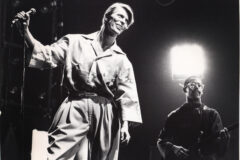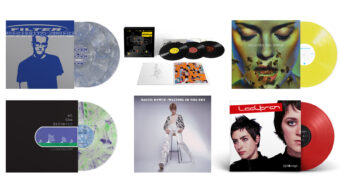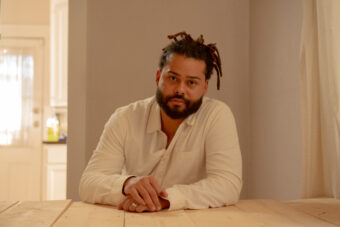In a slightly sketchy part of north London, a cockney blonde whom we’ll call Myrtle smokes a cigarette in the driveway of the plain white-fronted former bakery that serves as recording studio, office, and grown-up clubhouse for the members of one of the worlds’ biggest bands, Coldplay.Myrtle says she works at the office next door, and when asked if the guys are good neighbors, she hedges.
“I guess so.They’re pretty quiet.Always comin’ in and out with guitar cases and such.”Raising one eyebrow, she confides, “They say they’re musicians — but you never hear any music comin’ from there.Could be selling heroin for all I know.Or maybe they are musicians.I think they’re just crap at what they do, is what I think.”
On this last point, Myrtle, despite her ignorance, speaks for many. Though few acts inspire such devotion — since their 2000 debut, Parachutes, Coldplay have sold more than 32 million records while wildly loyal fans pack their live shows, which resemble artfully lit New Year’s parties — the group is often dismissed for churning out overly earnest, midtempo “hokum” (per the eviscerating New York Times review of their last album, 2005’s X&Y). A recent Travelodge hotel survey declared Coldplay the band most likely to put people to sleep; and a sneering dig in The 40-Year-Old Virgin (“You know how I know you’re gay? You like Coldplay.”) inspired howls of recognition.
The band’s fourth album, Viva La Vida, answers critics with canny experimentation, honed under the guidance of producer Brian Eno (guru to U2, David Bowie, and Talking Heads, among many others), with help from Markus Dravs (Arcade Fire’s Neon Bible) and Rik Simpson. In the arc of Coldplay’s career, Viva La Vida may be their Achtung Baby, on which U2 tweaked their self-serious image and explored new sounds in an idiom that still lured stadium crowds. Early response to Viva suggests that the experiment succeeds (see review on page 91).Even the most bilious bloggers reluctantly praised the album’s first single, “Violet Hill,” which bridges Coldplay’s old and new styles, with Chris Martin’s pretty piano picking its way across ruthless industrial beats. (Six hundred thousand people snagged the free download on the day of the single’s release, crashing the band’s website.) But the second single, “Vida La Vida,” better showcases the group’s new style: A big, blasting waterfall of wide-wale strings, timpani rolls, and heart-out harmonies make this the song you’d want playing in the background if you ever got the chance to slide down a mile-long hallway in stocking feet.
The four bandmates — Martin, guitarist Jonny Buckland, bassist Guy Berryman, and drummer Will Champion — met as undergraduates at London’s University College in the late ’90s, that pre-Cambrian age when human beings had to leave their houses to buy albums and new artists had to sign away their lives to corporate behemoths for a shot at stardom. Martin’s status as old-school mass-media royalty was ratified by his 2003 wedding to Gwyneth Paltrow; and by 2005, the group’s multigenerational audience had grown so broad, and their brand so valuable, that EMI, the parent company of their label, Capitol, had to amend its profit forecast when the release of X&Y was delayed. Where such reputations and fortunes are at stake, schadenfreude always licks her lips.
So it’s easy to understand why, a few hours after Myrtle’s pronouncement in the driveway, the 31-year-old Martin begins a merchandising meeting inside the Bakery with this question: “Is somebody making a T-shirt that says I HATE COLDPLAY? It would sell millions.” (The idea, though funny, is not unprecedented; Amy Winehouse pulled the same trick on her tour last year.) Brainstorming, Martin puts some stick in the subversion: “And sell it outside the concert, across the street from the stadium or wherever, so it looks like a bootleg.”
It’s the first week of May, and the band members are seated around a big hardwood dining table on the Bakery’s second floor, an open-plan loft with white walls and plank floors, beanbag chairs, a brown suede wraparound sofa, and racks of clothing they designed themselves to wear on their upcoming concert tour. They purchased the building two years ago, in part so they’d have a place to gather at times like this.
“The worst thing that could happen is people would buy it,” says Berryman, 30, of the hypothetical shirt.
Mock piously, Martin adds, “Life is about bringing the positive out of the negative. Silver linings and all that.”
Sometime after 2002’s A Rush of Blood to the Head, Coldplay temporarily parted ways with their original manager, an affable, exquisitely well-mannered childhood friend of Martin’s named Phil Harvey, so integral to the group that he’s listed on albums as the band’s fifth member. On X&Y, however, Martin says, Coldplay “turned over too many of the decisions to the wrong people,” meaning, basically, the label. Now, with Harvey back, they’re making all the decisions themselves, from the details of merchandising to designing the toy-crammed set for their concerts — a trampoline, lights whizzing around the stage on tracks, inflatable video globes whose projections employ planetarium technology — and, at the same time, trying to be good dads.(All four are fathers now; all but Buckland, who lives with his girlfriend, are married.)
“The problem with wanting to control everything,” Buckland, 30, complains, half joking, “is that you have to control everything.” The band work down the long to-do lists on dry-erase boards hanging in the Bakery’s living room deliberately, and with a bit of frenzy, because there’s no way of knowing how anyone could achieve the objective they’ve chosen. To wit: A big photo of the Beatles dominates the hallway leading to this room. “We’re goin’ for the big bomb,” says Buckland. Just now hitting their prime, Coldplay openly covet the title of Biggest Rock Band in the World at a moment when the position seems in danger of being permanently downsized.
Continue reading our entire Coldplay cover story in SPIN Digital >>





